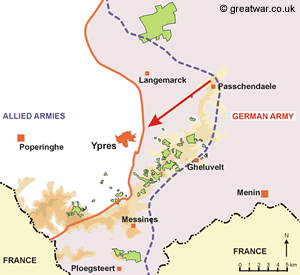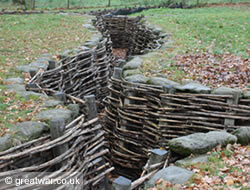Ypres Salient Battles 1918
- Fourth Battle of Ypres (Battles of the Lys)
09-Apr-1918—
29-Apr-1918
The Front Line (orange line) at the end of the German April Offensive from 9th to 29th April 1918. This line marks the farthest point of the German Army's advance to the west. Ypres was not captured. 
A Flanders offensive by the German Army was originally proposed in October 1917 by the Army Group Commander Field Marshal Prince Rupprecht of Bavaria as a large-scale attack either carried out on its own or as an attack to relieve pressure elsewhere on the German Front. Rupprecht's Army Group consisted of four German Armies holding the German Front in Flanders and Picardy; his command covered the Belgian coast to Ypres and on to Armentieres, from there through Artois to the east of Arras and southwards to St. Quentin on the river Somme.
In the original October 1917 plan the operation was given the codename of “George” and plans were submitted for an offensive on the Flanders Front between Ypres and Bethune. The breakthrough would be made in the British Front just south of the Belgian-French border in the Lys river area with the intention to pierce the Allied Front there and advance westwards making for Hazebrouck. This would cut the British Second Army holding the Front north of the Lys river away from the British First Army holding the line in Artois. The British-held rail centre of Hazebrouck would be captured and the British troops in Belgian Flanders could be pushed westwards and trapped on the Belgian coast. The operation would, however, only be possible to start from April at the earliest due to the high winter water table of the Lys river. The ground would not begin to dry out until the warmer spring weather arrived in April.
Between November 1917 and January 1918 the plans for a German offensive against the Allied Front in the spring of 1918 were developed. By January 1918 the German Supreme Command confirmed that the offensive would take place in a series of attacks rather than one great anihilating attack. Operation “George” was reduced in scale, renamed “Georgette” and timed to be launched in mid April after the first blow had been dealt to the Allies with the “Michael” attack in the Somme region from 21 March.
After initial success in breaking through the British Front Line and advancing several miles into Allied territory, the German Armies taking part in the “Michael” operation were held at a line east of Amiens. The German troops were exhausted, lines of supply had proved difficult to maintain across the shell-damaged ground, food was in short supply for men and horses. On 5th April the German Supreme Command sent a message to German Army Commanders that Operation “Michael” was terminated.
In the early morning of 9 April the German Fourth and Sixth Armies launched the Flanders offensive, operation “Georgette”, the second in the planned series of attacks on the Allied Front for spring 1918. South of Ypres the Portuguese troops holding the Allied Front in Artois were pushed westwards by four miles. In the south of the Ypres Salient sector the British Second Army was pushed westwards also, losing its hold of the Messines Ridge, Wytschaete and Messines villages which had been captured from the German Army in June 1917, just under a year before. The village of Passchendaele, captured by the Allies after such hard fighting during the Third Battle of Ypres, was retaken by the German Army on 16 April. South of Ypres the German advance was held at Kemmel Hill (Kemmelberg). However, a German attack on Kemmel Hill on 25 April succeeded in pushing French troops, recently arrived in the area as reinforcements, off this important high ground. The Georgette operation continued for another four days but was terminated on 29 April with no more significant German gains and without the capture of Hazebrouck.
The Fourth Battle of Ypres (Battles of the Lys) comprised 7 phases:
- Battle of Éstaires
09-Apr-1918—
11-Apr-1918
German forces break through the Allied Front to Éstaires, causing very high casualties to two Portuguese divisions.
- Battle of Messines 1918
10-Apr-1918—
11-Apr-1918
German forces attack north of Armentieres and capture Messines. The British situation is desperate. Field Marshal Sir Douglas Haig, Commander-in-Chief of the British Expeditionary Force (B.E.F.), issues his now famous order: “There must be no retirement. With our backs to the wall and believing in the justice of our cause each one must fight on to the end.”
- Battle of Hazebrouck
12-Apr-1918—
15-Apr-1918
A German attack with the intention of capturing Hazebrouck is stopped by the Australian 1st Division. French reinforcements are sent on their way to the British sector, specifically the Kemmel sector south of Ypres, to help stem the German advance.
- Battle of Bailleul
13-Apr-1918—
15-Apr-1918
A German attack captures Bailleul. General Plumer, commander of the British Second Army, withdraws British troops on his northern flank from Passchendaele closer to Ypres.
- Passchendaele is reoccupied by German forces.
16-Apr-1918
- First Battle of Kemmel Ridge or First Battle of Kemmelberg
17-Apr-1918—
19-Apr-1918
The British repulse a German attack on the high ground of the Kemmelberg.
- Battle of Béthune
18-Apr-1918
German forces attack to capture Béthune but are unsuccessful.
- Second Battle of the Kemmelberg
25-Apr-1918—
26-Apr-1918
A French division arrives at the Kemmelberg to relieve the British defenders. However, the German forces attack and capture it from the French.
- Battle of the Scherpenberg
29-Apr-1918
A German attack captures the Scherpenberg heights to the north-west of Kemmelberg.
- Battle of Éstaires
- Battle of Ypres 1918
28-Sep-1918—
02-Oct-1918
This battle was also known as the Advance in Flanders or the Battle of the Peaks of Flanders. Unofficially it is sometimes known as the Fifth Battle of Ypres. On 28 September 1918 the Allied Army Group of Flanders attacked and broke through the German Front to the north, east and south of the city of Ypres. This Allied Army Group comprised British, French and Belgian divisions and was under the command of King Albert I of Belgium. Casualties were over 4,500 for both the British and the Belgian forces. The progress of the advance was significant, with the recapture of the Kemmelberg and several miles of territory lost to the German advance in April earlier that year.
- Messines is retaken by British forces.
28-Sep-1918
- Passchendaele is retaken by Allied forces.
29-Sep-1918
The Allied advance to the west, pushing the German Army further away from Ypres and the destruction left in the area from four years of fighting, continued with the Battle of Courtrai.
- Messines is retaken by British forces.
Further Reading

The Battle for Flanders: German Defeat on the Lys 1918 (hardback)
by Chris Baker
This book tells of the defence by the Allied Armies in April 1918, against the might of the German Army in its final large-scale attack as part of its Spring Offensive. The Allies had their backs to the wall, and the Germans almost succeeded in breaking through the Allied line in the sector of the Western Front north of Lille and south of Ypres. The German attack encountered difficulties of supply and organization, leading to problems with low morale and an unsuccessful offensive.
Related Topic
German trench system preserved near Wijtschate.
